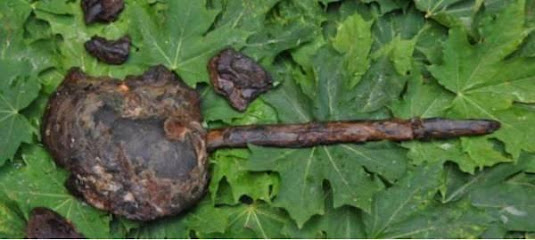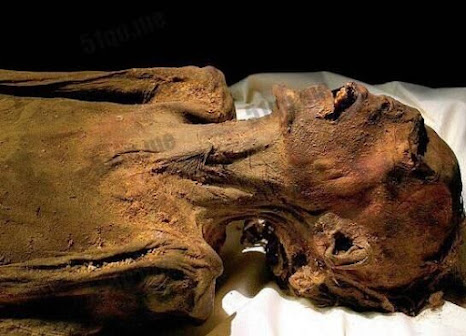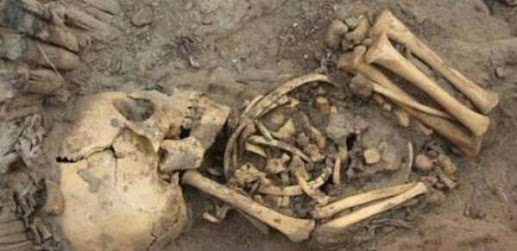10. Henry IV's head
As if Henry IV's unlucky death by assassination was not enough, he did not rest in peace when he was dug out of his grave and beheaded in 1793.
Since then, the whereabouts of Henry IV's head have been a mystery. It was not until 2010 that Henry IV's head was found in the house of a retired tax collector named Jacques Belanger. The head was found in the attic of a retired tax collector named Jacques Belanger. The skull had been auctioned off by a French couple in the early 1990s and was then purchased by Jacques Belanger. It was then purchased by Jacques Bérenger. The head was later found to match the king's portrait using digital facial reconstruction and a CT scan. Although DNA tests in 2013 showed that the head was not related to Henry IV's royal family.
9. The hanging skull
What would you do to your enemies? Tie their bloody skulls to a post? And leave them for archaeologists to dig up thousands of years later? It may not have been planned by the Stone Age Swedes, but that's what actually happened, and in 2009, historians stumbled upon the remains of 11 skulls that had been sunk at the bottom of a lake, at least two of which had been cracked to pieces with sticks.
It is unclear whether these skulls belonged to enemies captured by the tribe, but the place where the bones were located was probably an altar with a mixture of animal bones and human remains.
8. Smallpox scab of the book
When you open a very old book, a book that is centuries old, you hope to find some relics? Perhaps a letter or a map that leads to a major discovery. What you certainly don't expect, and certainly don't want, is to see an envelope filled with human blood scabs.
That's what happened at Santa Fe University's Fogel Library in 2003. That's what happened at the Fogel Library at Santa Fe University in 2003. When Suzanne Caro opened a book published in 1888. When Suzanne Caro opened an 1888 book on Civil War medicines, she found an envelope enclosed that read "Scabs taken from the child of W.B. Arrington, a vaccinator. The Centers for Disease Control intentionally took samples from the bodies of smallpox patients, and Ms. Caro has since gone through every old book she gets, cover to cover. As a result, government health officials gained first-hand knowledge of the evolution of smallpox as a disease.
7. Essex sarcophagus
This discovery was a complete surprise to Stephen Drake of Willingham Auctioneers in Cambridge. Drake was completely unexpected. When he first saw the dilapidated Bradwell Seaview house, he never expected to find anything. He was wandering around the house, which was just halfway through a renovation. Drake found a large hole in the wall, through which he saw the 3,000-year-old sarcophagus.
The relatives of the late owner of the house had no clue about it. The University of Cambridge certified and investigated the sarcophagus, and found that it was indeed a treasured artifact. But it raises questions about where the previous owner got the sarcophagus and where the mummy inside went.
6. Nazca painting
The aerial view of the Nazca desert in southern Peru looks somewhat similar to a child's sketch. There are about 70 different kinds of animals and hundreds of irregular geometric patterns in the painting. Some paintings resembling trees and flowers have been deeply etched into the desert. The story behind the discovery of these paintings is not so strange, as some people believe that they were made by aliens. These imprints were discovered in 1553. The discoverer at the time, Pedro Huesca, was a man who had been working in the desert. The discoverer at the time, Pedro Huesa. De Leon The discoverer, Pedro Chiesa de Leon, mistook them for trail markers. These marks were later found by the Peruvian historian Toribio Hia. Hia. These marks were later recorded in detail by the Peruvian historian Toribio Cserbi. One view is that these paintings were created by the Nazca to please their gods. The other view is more scientific, pointing to early human exploration of astronomy, celestial bodies, and astronomical calendars.
5. Mummies of Pain
Also known as the Screaming Mummy. This decaying corpse is said to be Prince Pentaval, the son of Pharaoh Ramses III and an accomplice to his murder. He appears to have died in extreme pain, his mouth framed in an open position, embalmed in a final helpless plea for help, preserved to this day. Most historians believe that the loose jaw is the result of unstitched jaws. But there is still one discovery on this mummy that sends chills down the spine. The entire mummy was wrapped in sheepskin, which was considered by the ancient Egyptians to be a symbol of unknottedness. The mummy's organs remained intact in his abdomen, and he was not marked with any guide marks in his tomb, which prevented him from entering reincarnation. How and why he was killed, and how he was mummified and buried, remain unsolved mysteries. But what is certain is that he was not properly mummified in the Egyptian red carpet style.
4. Early Chemical Warfare
Chemical warfare was a horrible thing, but it was also seen as a new way of modern warfare. Chemical weapons were used in World War I and became well known. In 2009, historians found evidence of the use of chemical weapons on 20 Roman soldiers found in Syria 70 years ago.
The Roman soldiers were found in a tunnel that the Romans had been digging when the Persians discovered them from the opposite side. Historians claim that the Persians, knowing that the Romans were digging the tunnels, began to wait for them and then gradually dropped a deadly mixture of sulfur and asphalt into the tunnels.
3. Headless pirate graves
In 2009, 51 pirate bodies were found in a burial pit in southern England.
The bodies had not been treated well, as the British had chopped off the pirates' heads and dumped the bodies here at random. Their heads were thrown into another pit. As if the beheadings were not enough, no clothing or ornaments were found around the grave, indicating that they were buried together naked and at random. The cuts on the skulls and jawbones of several of the bodies indicate that they were beaten and tortured before death and that the beheadings were not a single cut.
2. Baby bones in the sewers
The Roman baths were a perfect place to rest and relax, so many questions arose when more than 100 infant bodies were found in the sewers of the city of Ashkelon.
After the discovery, research showed that the vast majority of the remains were intact, which means that the babies were thrown into the sewers either before they died or just before they died. All of the babies should have died shortly after birth due to the lack of a nursery. There were no skeletal deformities or signs of disease on these bodies. Sadly, without knowing the exact cause of death of these babies, researchers speculate that the 100 babies may have died as a result of murder, famine, war, or perhaps even the accidental birth of a prostitute.
1. The Team Mass Graves in Galway County
Mass graves are not uncommon in history and all have a sad story behind them, but few are as tragic as this one.
Some 796 babies and young children were found buried in a septic tank in a single mother's home in Teignmouth, County Galway, Ireland. From 1925-1961, this place was run by Sister Bon Hicks. Sister Bon Hicks was in charge. After it was discovered that she had ignored the malnutrition of the children, she confessed to abusing them. Apparently, when the children died, and many of them did, from pneumonia, measles, gastroenteritis, and tuberculosis, the babies were wrapped in unmarked shrouds and buried near an old watering hole near the house. After the discovery, the mass grave did not receive attention, and real estate was built nearby.










Comments
Post a Comment